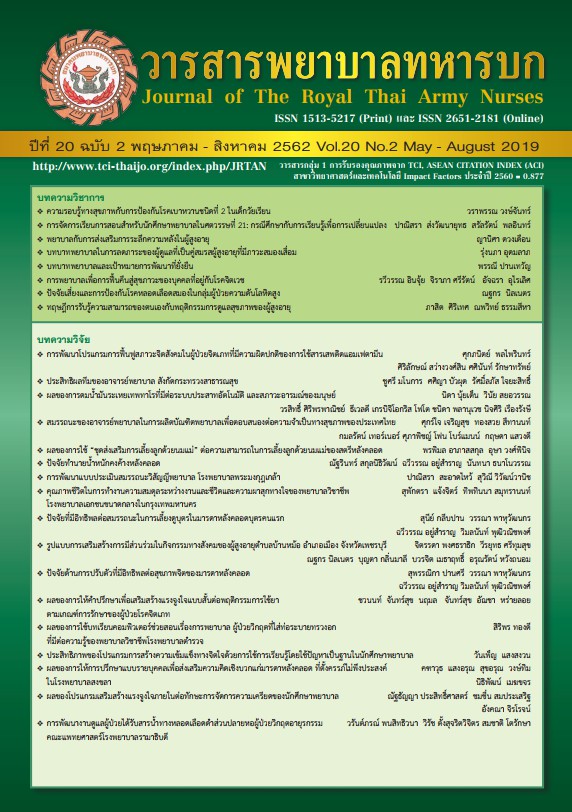The Effect of Using A Computer Assisted Instruction (CAI) About Nursing Care of Critical Patients with Intercostal Drainage Toward Knowledge of Professional Nurses in Police General Hospital
Keywords:
computer-assisted instruction, critical patients with intercostal drainageAbstract
The purposes of this study were to 1) compare knowledge of professional nurses about critical patients with intercostals drainage (ICD) in an experiment group of profession nurses before and after using a computer assisted instruction (CAI),2)compare knowledge of professional nurses about critical patients with ICD in experiment group and a control group, and 3) study satisfaction of professional nurses influence using CAI. The samples were purposive selection twenty critical professional nurses in Police General Hospital. They were divided into two groups by simple random sampling. The experimental group 10participants received CAI and control group 10participants received normal teaching. The instruments were 1) CAI about nursing care of critical patients with ICD,2) test of knowledge about nursing care of critical patients with ICD, and 3) questionnaires of satisfaction for professional nurses using CAI. The statistics were percentage, mean, median, quartile deviation, standard deviation, Wilcoxon Signed Rank test, and Mann-Whitney U test. The research results were:1) the experiment group after using CAI had higher median of knowledge about critical patients with ICD than before using CAI and statistically significance at .01 level,2) The experiment group of professional nurses had higher median of knowledge of professional nurses about critical patients with ICD than the control group and statistical significance at .01 level, and 3) The professional nurses had overall satisfaction the CAI about critical patients with ICD in high level. Therefore, new critical professional nurses should be encouraged to be taught and review knowledge with CAI along with practice in order to increased knowledge of nursing care.
Downloads
References
2. ICU Trauma. Statistical report in I.C.U. trauma at Police General Hospital. 2016.
3. Corcoran JP, Hallifax RJ, Talwar A, Psallidas I, Sykes A, Rahman NM. Intercostal chest drain insertion by general physicians: attitudes, experience and implications for training, service and patient safety. Postgraduate Medical Journal. 2015; 91(1075): 244-250.
4. Harris A, O’Driscoll BR, Turkington PM. Survey of major complications of intercostal chest drain insertion in the UK. Postgraduate Medical Journal. 2010; 86(1012): 68-72.
5. Raetong, P. Role change experience: from nursing students to registered nurses. Thai Journal of Nursing Council. 2012; 27(2): 51-62.
6. Mamom J. Outcomes of computer-mediated review lesson on pressure-sore dressing as observed in second-year nursing students’ knowledge, practical skills and opinions. Thai Journal of Nursing Council. 2012; 27(3): 63-76.
7. Erb-arbS, Leevirat S. Effects of computer-assisted instruction for aerosol administration therapy in children on nurses’ knowledge and medication management skills and on children’s respiratory response. Thai Journal of Nursing Council. 2014; 29(4): 105-120.
8. IamsupasitS. Theories and techniques in behavior modification. Bangkok: Chulalongkorn University Printing House. 2013. (in Thai).
9. Norasan S, Khuwatsamrit K. The effect of computer-assisted instruction (CAI) on nursing student’s learning achievement toward nursing management for patients with intercostal chest drainage (ICD). Journal of Nursing and Education. 2008; 1(3): 50-62.
10. Buranasak J, Limruangrong P, Pungbangkadee R. The effect of computer assisted instruction of abdominal examination on knowledge, abdominal examination skills and satisfaction of nursing students. Journal of The Royal Thai Army Nurses. 2014; 15(3): 361-370. (in Thai).
11. Thongsawai S. Teaching technology with computer-assisted instruction. Academic journal 2009; 12(1): 49-53.
Downloads
Published
How to Cite
Issue
Section
License
บทความหรือข้อคิดเห็นใดใดที่ปรากฏในวารสารพยาบาลทหารบกเป็นวรรณกรรมของผู้เขียน ซึ่งบรรณาธิการหรือสมาคมพยาบาลทหารบก ไม่จำเป็นต้องเห็นด้วย
บทความที่ได้รับการตีพิมพ์เป็นลิขสิทธิ์ของวารสารพยาบาลทหารบก
The ideas and opinions expressed in the Journal of The Royal Thai Army Nurses are those of the authors and not necessarily those
of the editor or Royal Thai Army Nurses Association.






